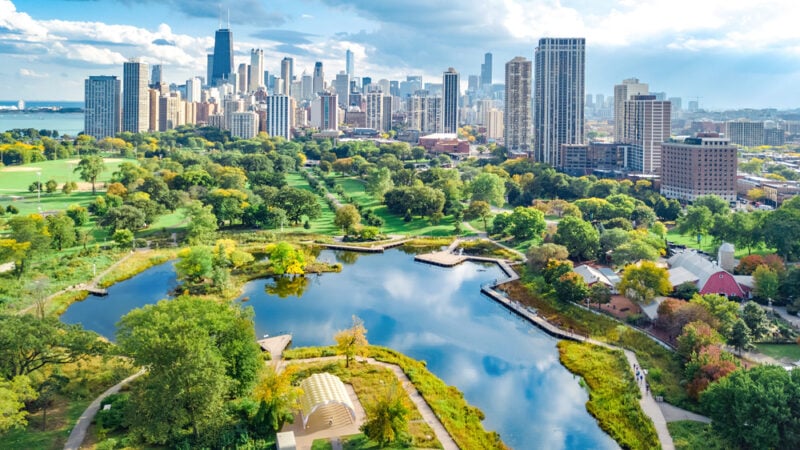The 30 Richest Places to Live in Montana: The State’s Most Affluent Communities
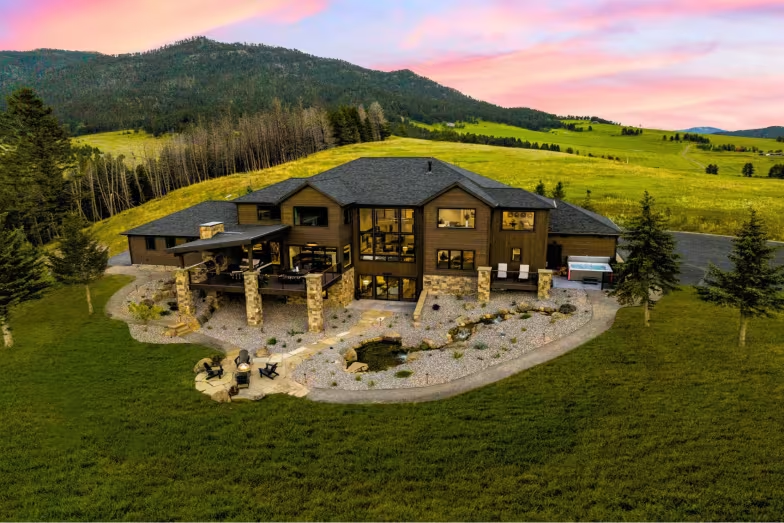
Montana’s economic landscape reveals surprising pockets of wealth scattered across the state’s diverse geography, from small census-designated places to established cities.
While the state’s median household income sits below the national average, numerous communities demonstrate exceptional prosperity through various economic drivers and lifestyle factors.
These affluent areas range from exclusive mountain retreats and resort towns to historic urban neighborhoods, each offering distinct characteristics that attract high-income residents.
The wealthiest communities span from tiny CDPs with extraordinary per-capita wealth to larger cities that combine economic opportunity with Montana’s renowned quality of life, creating a comprehensive picture of where prosperity flourishes in Big Sky Country.
Here are the 30 richest places to live in Montana:
1. Bridger CDP
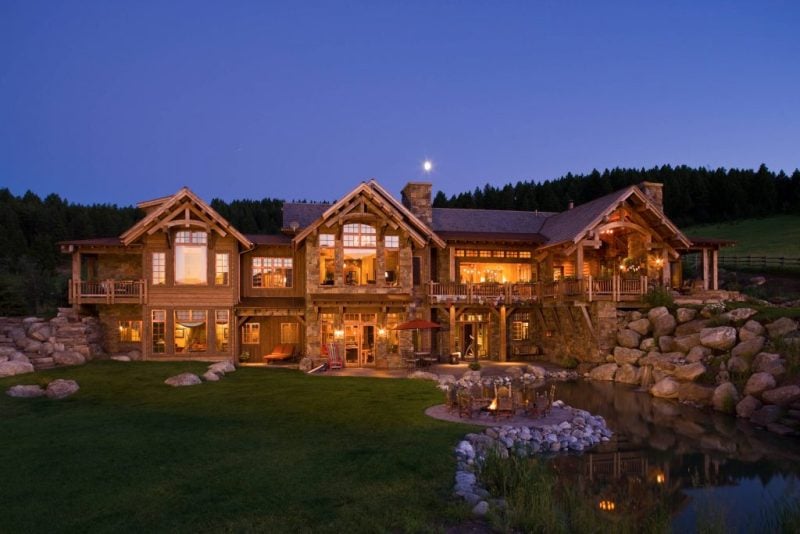
Bridger CDP stands as Montana’s wealthiest community with an average household income of $354,683. This small census-designated place houses only 119 residents, creating an exclusive enclave of prosperity.
The community operates as a CDP rather than an incorporated town. This means Bridger lacks traditional municipal structures like mayors or main streets that characterize typical Montana cities.
Despite its modest population size, Bridger represents the pinnacle of affluence in Big Sky Country. The high average income reflects the concentrated wealth within this small residential cluster.
Bridger’s status as a census-designated place allows it official recognition for statistical purposes. This classification helps track demographic and economic data for what would otherwise be an unincorporated area.
The community’s exceptional income levels set it apart from Montana’s median household income of $67,631.
2. Gallatin River Ranch
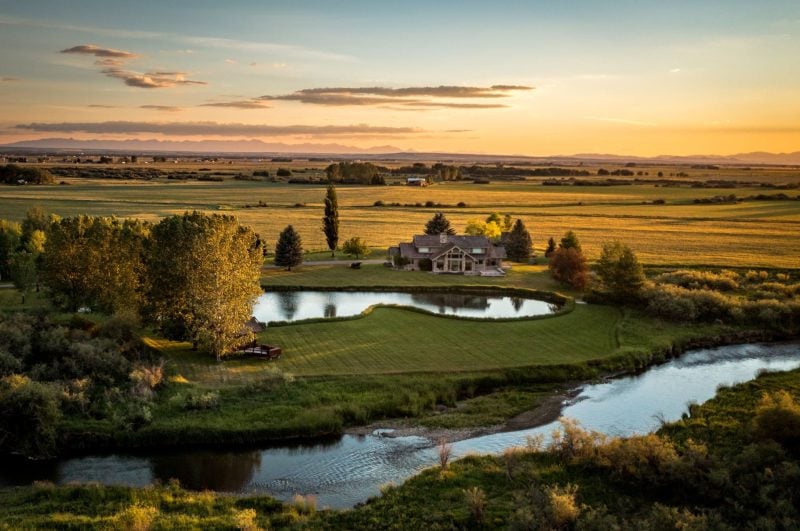
Gallatin River Ranch claims the top position as Montana’s wealthiest community. This private residential development sits northwest of Bozeman in the Horseshoe Hills.
The community encompasses 5,900 acres along the Gallatin River. Only 78 households call this exclusive area home.
Median household income exceeds $250,000 annually. Home values average around $1.4 million, with property taxes near $7,800 per year.
Individual parcels range from 20 to 60 acres each. The varied topography offers stunning views of eight mountain ranges and the valley floor below.
Residents enjoy direct access to the Gallatin River for fishing and boating. The location provides abundant outdoor recreation opportunities including hiking, skiing, and wildlife viewing.
This census-designated place represents luxury living in rural Montana. The financial metrics rival those found in high-end coastal markets rather than typical Montana communities.
3. Rollins
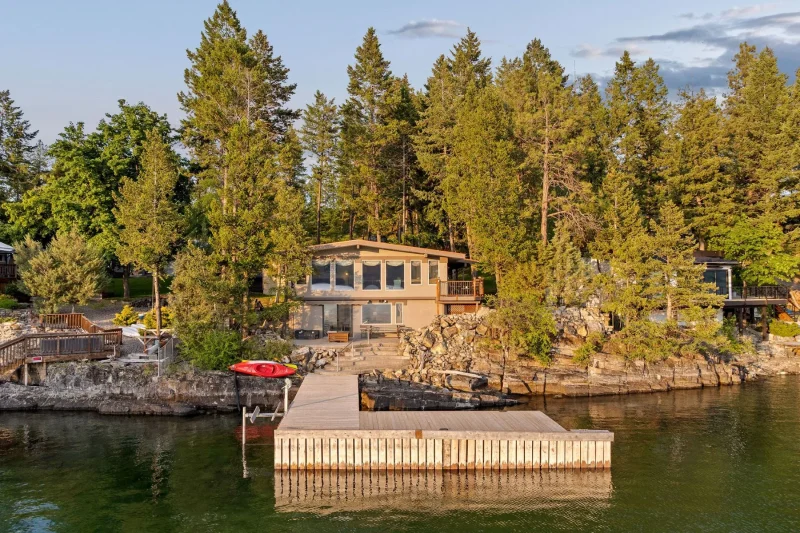
Rollins stands as the second richest place in Montana according to recent census data. This unincorporated community sits in Lake County along the western shores of Flathead Lake.
The census-designated place represents one of Montana’s wealthiest areas despite its small size. Rollins demonstrates how tiny communities can achieve remarkable prosperity in Big Sky Country.
The lakefront location provides residents with stunning views and recreational opportunities. Flathead Lake’s pristine waters make this area particularly desirable for affluent buyers.
Property values in Rollins reflect the community’s exclusive nature and prime positioning. The combination of natural beauty and limited development creates a premium real estate market.
Rollins exemplifies Montana’s pattern of small, high-income communities outpacing larger towns in wealth concentration. This tiny lakeside enclave attracts residents seeking luxury living in a secluded mountain setting.
4. Big Sky
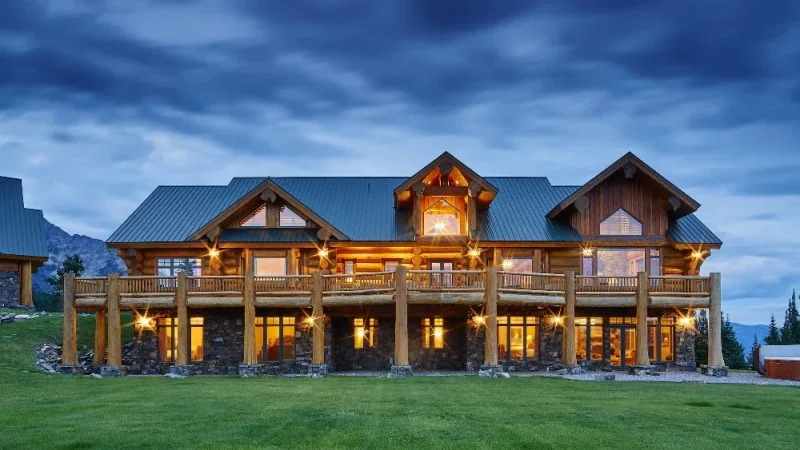
Big Sky stands as one of Montana’s most prestigious destinations for wealthy residents. The resort community attracts affluent individuals year-round, with particular popularity during ski season.
The median home price in Big Sky reached nearly $2 million in 2025, specifically $1,851,233. This reflects the area’s status as an exclusive enclave for high-net-worth individuals.
Big Sky’s proximity to the Yellowstone Club enhances its appeal among the wealthy elite. The area features numerous high-dollar homes and luxury condominiums that cater to affluent buyers.
High demand and extremely low supply drive the community’s elevated cost of living. These market conditions contribute to Big Sky’s reputation as one of Montana’s premier wealthy enclaves, consistently ranking among the state’s top affluent neighborhoods.
5. Whitefish
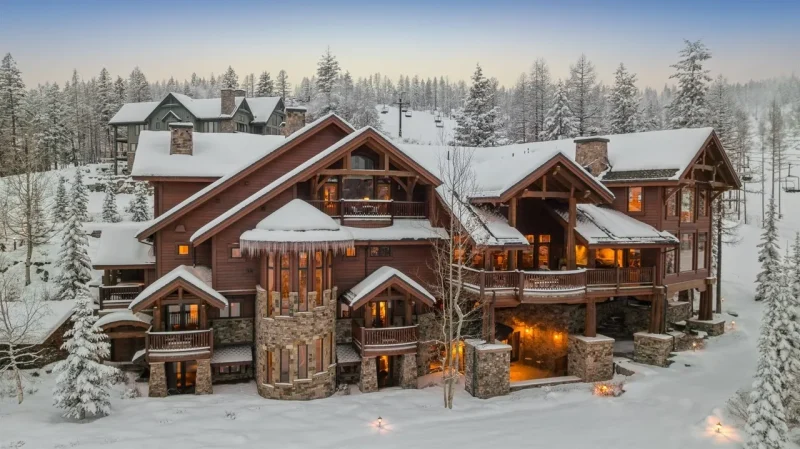
Whitefish consistently ranks as one of Montana’s wealthiest and most expensive places to live. The mountain town attracts affluent residents who value its natural beauty and exclusive amenities.
Home prices in Whitefish significantly exceed Montana’s state average of $298,413. The average home cost reaches approximately $863,174, making it the third most expensive city in the state.
The town draws wealthy individuals beyond just celebrities, though several famous residents call Whitefish home. Many affluent locals live both within the town limits and in surrounding areas.
Whitefish real estate features stunning mountain views, outdoor living spaces, and high-end finishes. Exclusive neighborhoods offer premium amenities including lakefront access, golf courses, and ski-in, ski-out properties.
The charming and friendly atmosphere combines with luxury living to create one of Montana’s most desirable residential markets.
6. Livingston
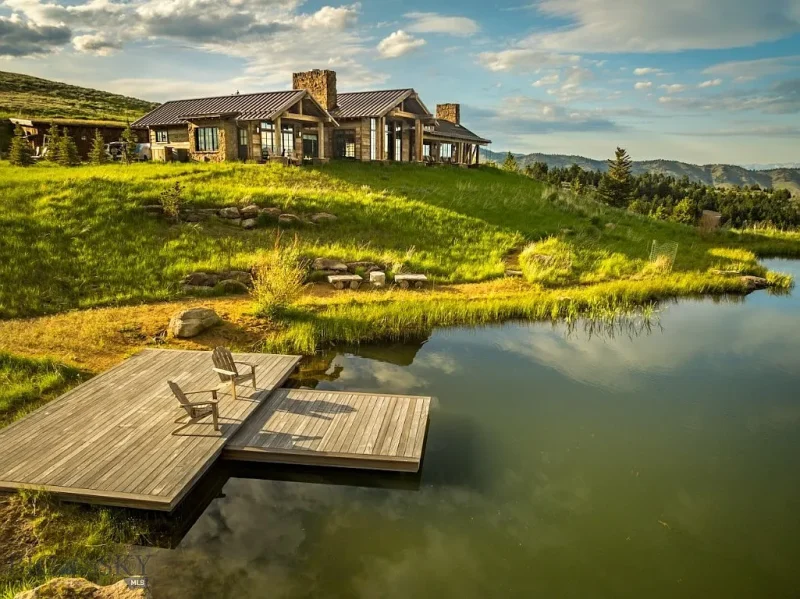
Livingston stands out as one of Montana’s most desirable communities for affluent residents. The city attracts wealthy individuals seeking mountain town charm combined with sophisticated amenities.
This historic railroad town sits in the Yellowstone River valley. It offers stunning views of the Absaroka and Gallatin mountain ranges.
Livingston ranks fourth among Montana’s best places for young professionals. The community maintains strong economic indicators despite being smaller than major cities.
Living costs run approximately 2% higher than the national average. They exceed Montana’s state average by about 8%, reflecting the area’s desirability.
The city serves as home to several billionaires and ultra-wealthy residents. These individuals are drawn to the area’s natural beauty and recreational opportunities.
Livingston’s neighborhoods feature high-value properties and luxury homes. The community combines Western heritage with modern affluence, creating an appealing environment for Montana’s wealthy residents.
7. Missoula
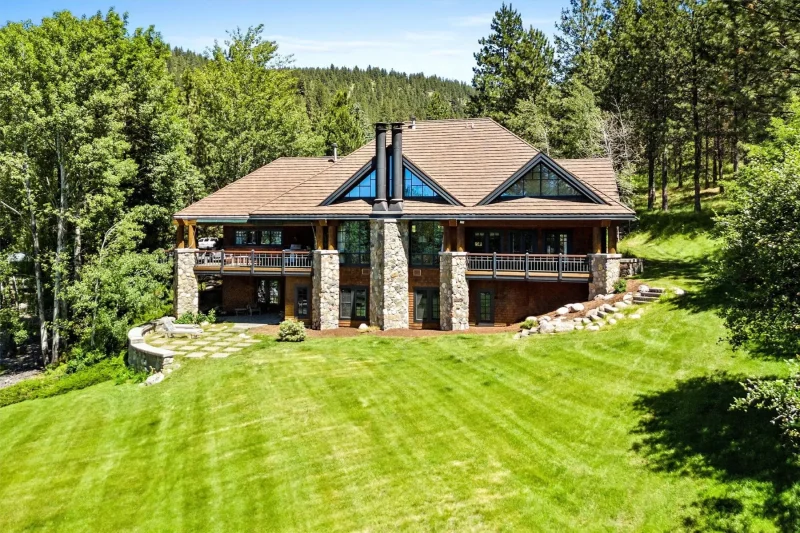
Missoula stands out as Montana’s billionaire capital, hosting two of the state’s wealthiest residents among its four total billionaires. The city has attracted significant wealth despite its modest median household income of $61,423.
Known as the “Garden City” for its dense trees and lush landscape, Missoula sits in western Montana’s heart. The community combines cultural richness with natural beauty, creating an appealing environment for affluent residents.
The presence of billionaires has elevated Missoula’s status among Montana’s wealthiest communities. This concentration of extreme wealth contrasts with the city’s reputation as a university town and cultural center.
Missoula offers immediate access to world-class outdoor recreation including skiing, hiking, and fishing. The city’s proximity to wilderness areas and national parks provides unparalleled recreational opportunities that attract wealthy individuals seeking luxury living in Big Sky Country.
8. Bozeman
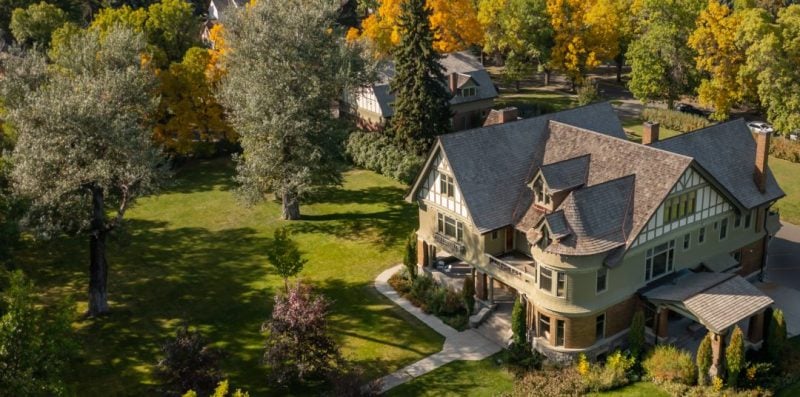
Bozeman ranks among Montana’s wealthiest cities with a median household income of $79,903. This figure sits approximately 15% higher than the state median of $70,804.
The city attracts affluent residents seeking both economic opportunities and mountain lifestyle amenities. Bozeman serves as home to Montana State University, contributing to its educated population and stable economy.
Housing costs reflect the area’s prosperity, with Bozeman being Montana’s most expensive city. The cost of living runs 8% higher than the Montana average and 30% above national figures.
Wealthy residents concentrate in premium neighborhoods like Bridger Canyon and Eagle Rock Reserve. Triple Tree Ranch, Black Bull Golf Community, and Manley Meadows also house the city’s most expensive properties.
The Bozeman-Livingston corridor attracts billionaires and ultra-wealthy individuals. This concentration stems from the region’s natural beauty combined with luxury lifestyle infrastructure.
9. Helena
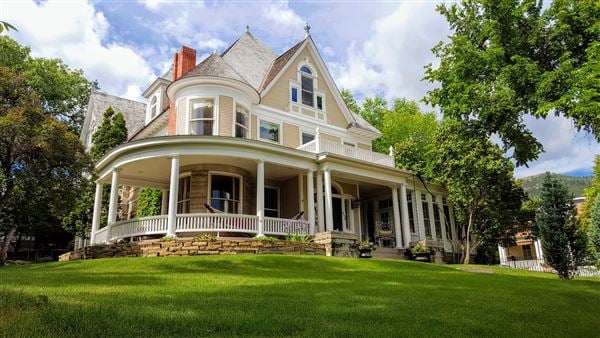
Helena serves as Montana’s capital city and features several affluent neighborhoods that attract wealthy residents. The city combines political importance with natural beauty, creating desirable living conditions for high earners.
Helena Valley Northeast stands out as the area’s most expensive neighborhood. Property values have more than doubled since 2010, with current median home prices reaching $633,477.
The neighborhood experienced remarkable growth of 74.8% since 2020 alone. Early buyers who purchased homes below $250,000 have seen significant wealth creation through property appreciation.
Helena’s position as the state capital brings stable employment opportunities in government sectors. This economic foundation supports higher property values and attracts professionals seeking luxury accommodations.
The city’s surrounding mountain landscapes and outdoor recreation access add to its appeal among Montana’s wealthy residents.
10. Lolo
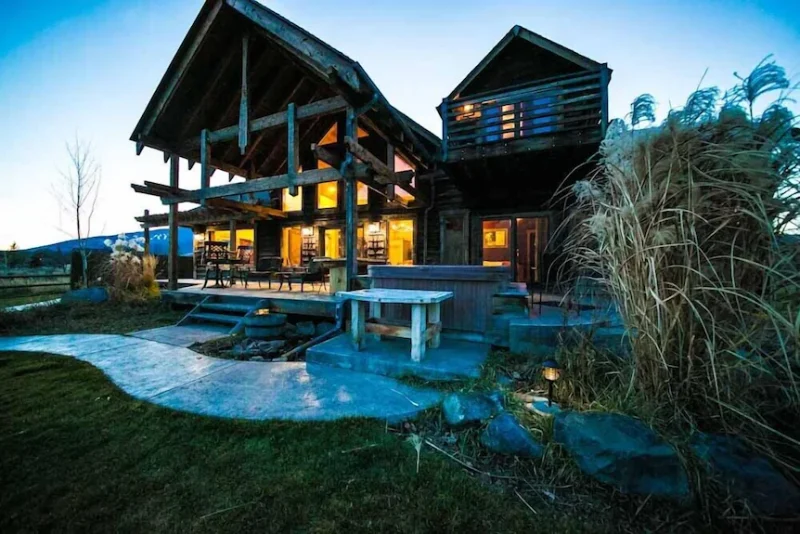
Lolo sits in western Montana’s Missoula County, positioned along the Bitterroot River. This small community benefits from its proximity to Missoula while maintaining a rural atmosphere.
The area attracts residents seeking larger properties and mountain views. Many homes feature acreage that provides privacy and space for outdoor activities.
Lolo’s location offers easy access to recreational opportunities in the Bitterroot Mountains. The community serves as a gateway to wilderness areas and fishing spots along the river.
Property values in Lolo reflect its desirable location and scenic setting. The area appeals to professionals who work in Missoula but prefer living outside the city.
Local amenities include small businesses and services that cater to the community’s needs. Residents often commute to nearby Missoula for additional shopping and employment opportunities.
11. Florence
Florence sits in the Bitterroot Valley, approximately 20 miles south of Missoula. This small unincorporated community attracts affluent residents seeking rural luxury with urban accessibility.
The area features expansive properties with mountain views and recreational opportunities. Many homes sit on multi-acre lots, providing privacy and space for equestrian facilities.
Florence benefits from its proximity to both Missoula’s amenities and Bitterroot National Forest recreation. The location offers a balance of convenience and natural beauty that appeals to wealthy homebuyers.
Property values in Florence reflect the area’s desirability among high-income residents. The community maintains a rural character while offering modern amenities and services.
The Bitterroot Valley’s agricultural heritage combines with contemporary development to create an attractive environment for Montana’s affluent population.
12. Victor
Victor sits in the Bitterroot Valley, approximately 45 miles south of Missoula. This small community offers residents a quieter lifestyle while maintaining access to urban amenities.
The town benefits from its proximity to the Bitterroot Mountains and Selway-Bitterroot Wilderness. Property values reflect the area’s natural beauty and recreational opportunities.
Victor attracts residents seeking mountain living without complete isolation. The community provides basic services while remaining within commuting distance of larger cities.
Housing costs in Victor tend to be higher than Montana’s rural average. The combination of scenic location and limited inventory drives property values upward.
Local amenities include outdoor recreation access and small-town community features. Residents often choose Victor for its balance of privacy and convenience in the Bitterroot Valley.
13. Red Lodge
Red Lodge stands out as one of Montana’s more affluent communities, with home prices significantly above the state average. The city’s real estate market reflects its desirability among wealthy residents seeking mountain living.
Property values in Red Lodge exceed Montana’s average of $298,413, making it one of the more expensive places to own a home in the state. The market dynamics indicate strong demand from buyers attracted to the area’s amenities.
Located in south-central Montana, Red Lodge offers residents access to outdoor recreation and scenic mountain views. The community attracts affluent individuals who value both natural beauty and proximity to recreational activities.
The local real estate market consistently demonstrates the community’s appeal to higher-income residents. Red Lodge’s neighborhoods represent some of the most sought-after residential areas in this part of Montana.
14. Columbia Falls
Columbia Falls stands out as one of Montana’s wealthier communities with a population of approximately 5,225 residents. The city maintains a relatively low unemployment rate of 2.6%.
The median household income reaches $47,716, positioning Columbia Falls among Montana’s more prosperous areas. The poverty rate sits at 12.7%, which remains below many national averages.
Home values in Columbia Falls align closely with Montana’s state average of $298,413. The local real estate market demonstrates stability and consistent demand from buyers.
Columbia Falls benefits from its strategic location near Glacier National Park. This proximity attracts both tourists and residents seeking access to outdoor recreation while maintaining economic opportunities.
The community combines small-town charm with financial stability. Local residents enjoy a balance of natural beauty and economic security that characterizes many of Montana’s affluent areas.
15. Kalispell
Kalispell sits in Flathead County, serving as the county seat and largest city in the region. The city has a median household income of $55,411, placing it among Montana’s more prosperous communities.
Located near Glacier National Park and Flathead Lake, Kalispell benefits from its proximity to natural attractions. This geographic advantage drives tourism revenue and attracts residents seeking outdoor recreation access.
The local economy relies on healthcare, retail, and tourism industries. Several major employers include Logan Health and various hospitality businesses catering to visitors.
Housing values in Kalispell have increased significantly in recent years. The city’s desirable location and limited housing supply contribute to rising property prices throughout established neighborhoods.
16. Polson
Polson sits along the southern shore of Flathead Lake in northwestern Montana. The city serves as the county seat of Lake County and houses approximately 5,033 residents.
The typical household in Polson earns $39,604 annually. This figure falls below the national median household income of $67,500 and Montana’s state median of $67,631.
Polson’s poverty rate stands at 12.3%, which is 12% lower than the national average. The city benefits from its scenic location on Flathead Lake, the largest natural freshwater lake west of the Mississippi River.
The local economy centers around tourism, agriculture, and small businesses. Polson serves as a gateway to recreational activities including boating, fishing, and outdoor adventures on and around Flathead Lake.
17. Hamilton
Hamilton sits in the Bitterroot Valley and attracts residents seeking upscale mountain living. The town features notable housing disparities with significant variation in neighborhood quality and home values.
Market data shows people actively seek out Hamilton’s best areas. These neighborhoods tend to have lower crime rates and higher quality of life standards.
The community offers financial stability above typical Montana averages. Residents benefit from the town’s proximity to outdoor recreation and scenic mountain views.
Hamilton’s real estate market reflects strong demand for quality neighborhoods. Home values in premium areas command higher prices due to location and amenities.
The town combines small-town charm with access to luxury amenities. Hamilton continues attracting affluent residents who value mountain lifestyle and community atmosphere.
18. Corvallis
Corvallis sits in the Bitterroot Valley of western Montana, surrounded by mountain ranges and agricultural land. The town maintains a small population while offering access to outdoor recreation and rural amenities.
Home prices in Corvallis reflect the area’s desirability among those seeking mountain living. The median home value aligns closely with Montana’s state average of $298,413, making it accessible compared to some of the state’s most exclusive communities.
The town attracts residents who value proximity to natural areas and a quieter pace of life. Corvallis provides a balance between rural Montana living and reasonable property values.
Agricultural heritage remains important to the community’s identity. Many properties feature larger lots that accommodate horses and other rural pursuits.
The location offers convenient access to Hamilton and other Bitterroot Valley communities while maintaining its distinct small-town character.
19. Bitterroot Valley
The Bitterroot Valley stands as one of Montana’s most desirable affluent areas. Known as the “Banana Belt of Montana,” this region attracts wealthy residents seeking tranquil mountain living.
Celebrity influence and high-net-worth individuals have driven significant property value increases. Notable figures from entertainment and business have established luxury properties throughout the valley.
Real estate options vary widely, with most homes featuring unique architectural designs. Cookie-cutter neighborhoods are rare, contributing to the area’s exclusive appeal.
The valley offers exceptional outdoor recreation opportunities alongside upscale amenities. Billionaires and wealthy residents have particularly impacted the local luxury market, with premium properties commanding substantial prices.
Geographic location provides both privacy and accessibility to major Montana destinations. The combination of natural beauty, celebrity presence, and luxury housing options solidifies Bitterroot Valley’s position among Montana’s wealthiest communities.
20. Paradise
Paradise sits in Sanders County along the Clark Fork River in northwestern Montana. This small community attracts residents seeking a quieter lifestyle while maintaining access to natural amenities.
The area features a mix of riverside properties and forested lots that appeal to those wanting privacy. Many homes take advantage of mountain views and river access for recreational activities.
Paradise benefits from its location between Missoula and the Idaho border. This positioning provides residents with outdoor recreation opportunities including fishing, hunting, and hiking.
The community remains small with limited commercial development. Most residents commute to nearby towns for work and shopping needs.
Property values in Paradise reflect the desirability of rural Montana living combined with natural beauty. The area continues to draw people looking for a retreat from urban environments.
21. Sidney
Sidney sits in the heart of Montana’s Bakken oil region in Richland County. The city experienced significant economic growth during the oil boom of the 2010s.
Oil and gas industry jobs brought higher-paying employment opportunities to the area. Many workers relocated to Sidney for these lucrative positions in energy extraction.
The median household income in Sidney reflects the community’s connection to the energy sector. Housing demand increased substantially during peak oil production years.
Sidney serves as a regional hub for agricultural activities alongside energy production. The combination of these industries creates multiple income streams for residents.
The city’s economy remains tied to commodity prices and energy market fluctuations. Sidney offers a small-town lifestyle with access to well-paying industrial jobs.
22. Billings
Billings stands as Montana’s largest city and economic powerhouse. The city boasts a median household income of $63,608, reflecting its diverse economic foundation.
Healthcare, education, trade, and transportation drive the local economy. Major employers include Billings Clinic, St. Vincent Healthcare, and the School District of Billings.
The median home price reached $397,089 as of August 2025, marking a 7% increase from the previous year. This positions Billings among the more expensive places to live within Montana.
Residents benefit from the city’s role as the state’s economic hub. The diverse job market provides stability and growth opportunities across multiple sectors.
Billings offers urban amenities while maintaining Montana’s characteristic lifestyle. The combination of economic opportunity and quality of life attracts professionals and families seeking prosperity in Big Sky Country.
23. Great Falls
Great Falls represents one of Montana’s economically diverse cities, combining industrial growth with cultural offerings. The city features neighborhoods with varying levels of affluence and home values.
The best neighborhoods in Great Falls are determined primarily by median home values. These areas tend to have lower crime rates and higher quality of life standards.
Housing disparity exists significantly within Great Falls boundaries. The quality and value of neighborhoods varies greatly across different sections of the city.
Great Falls offers growing industry and expanding job opportunities alongside rich arts and culture. This combination attracts residents seeking both economic stability and cultural amenities.
The city’s real estate market presents investment opportunities in select neighborhoods. Prime areas show potential for property value appreciation and rental income generation.
24. Havre
Havre sits in north-central Montana along the Milk River. The city serves as the county seat of Hill County and has a population of approximately 9,300 residents.
The local economy centers around agriculture and the BNSF Railway. Havre acts as a regional hub for grain shipping and livestock operations throughout the Hi-Line region.
Housing costs in Havre remain significantly below state and national averages. The median home value typically falls between $120,000 and $140,000, making it accessible for middle-income families.
Montana State University-Northern provides educational opportunities and employs many local residents. The university contributes to the city’s economic stability through both jobs and student spending.
Havre offers basic amenities including healthcare facilities, shopping centers, and recreational opportunities. The city maintains several parks and provides access to outdoor activities like hunting and fishing in the surrounding area.
25. Cut Bank
Cut Bank sits in northern Montana with a population of 3,232 residents. The city has earned recognition as one of the better places to live in the state.
Cut Bank ranks highly in several key categories including livability, amenities, and cost of living. The community also scores well for educational opportunities.
Residents enjoy easy access to outdoor recreation activities. Fishing and hunting opportunities are readily available in the surrounding area.
The city provides a balance of small-town living with practical amenities. Cut Bank maintains its position as a desirable location for those seeking affordable Montana living.
Living costs remain reasonable compared to other Montana communities. This affordability factor contributes to Cut Bank’s appeal among residents looking for value in their housing choices.
26. Deer Lodge
Deer Lodge sits in Powell County with a population of approximately 3,035 residents. The town offers a suburban rural mix atmosphere where most residents own their homes.
The median household income in Deer Lodge is $46,799, which falls below both the national median of $67,500 and Montana’s state average. This places Deer Lodge among the more affordable communities in the state.
Home prices in Deer Lodge are significantly lower than Montana’s average of $298,413. The poverty rate stands at 16.2%, which is 16% higher than the national average.
The community attracts many retirees and tends to lean conservative politically. Deer Lodge features numerous bars and establishments that serve the local population.
Despite lower income levels compared to other Montana locations, the town provides affordable homeownership opportunities and a quiet rural lifestyle for residents seeking a slower pace of living.
27. Anaconda
Anaconda sits in southwestern Montana, surrounded by the Anaconda-Pintler mountain range. This former copper smelting boomtown carries significant historical importance from Montana’s mining era.
The city offers affordable housing options compared to many other Montana communities. Residents benefit from lower living costs while maintaining access to outdoor recreation opportunities.
Anaconda’s economy has diversified since its copper industry heyday. The community now attracts residents seeking affordable mountain living with historical character.
The city provides access to hiking, fishing, and skiing in the nearby mountain ranges. Its location offers scenic beauty without the premium prices found in resort towns.
Anaconda ranks lower on wealth indicators compared to Montana’s most affluent areas. However, it presents value for residents prioritizing affordability and outdoor access over luxury amenities.
28. Lewistown
Lewistown offers affordable living compared to Montana’s typical housing market. Home prices in this central Montana community fall well below the state average of $298,413.
The city provides a cost-effective option for residents seeking Montana living without premium price tags. Local neighborhoods vary in value, with market preferences determining the most desirable areas.
Lewistown’s housing market reflects its position as a practical choice rather than a luxury destination. The community attracts residents looking for reasonable real estate costs in a rural Montana setting.
Living expenses remain manageable compared to other Montana locations. The area’s affordability makes it accessible to middle-income families and retirees seeking budget-conscious options.
29. Glendive
Glendive sits in eastern Montana along the Yellowstone River. The city serves as the county seat of Dawson County.
Home values in Glendive remain significantly below Montana’s state average of $298,413. The median listing price reached $230,000 in March 2024, marking a 24.4% increase from the previous year.
The local real estate market has shown notable changes recently. Properties in Glendive cost about the same as similar-sized cities across the country.
Glendive offers diverse housing options for residents. The community provides affordable living compared to other Montana locations like Bozeman or Whitefish.
The area attracts buyers seeking value in Montana’s real estate market. Glendive represents accessible homeownership in Big Sky Country without premium pricing found in resort towns.
30. Miles City
Miles City sits in southeastern Montana along the Yellowstone River. The community serves as the county seat of Custer County and maintains a strong agricultural economy.
The city’s wealth stems primarily from ranching and farming operations in the surrounding area. Cattle ranching remains a significant economic driver for local families.
Miles City hosts the annual Bucking Horse Sale, which attracts visitors and generates revenue for the local economy. This event has become a notable source of income for area businesses.
The median household income in Miles City reflects the stability of its agricultural base. Property values remain moderate compared to Montana’s mountain resort communities.
Local banks and financial institutions serve the ranching community’s needs. The city’s economy benefits from its position as a regional agricultural center in eastern Montana.
Economic Factors Influencing Montana’s Wealthiest Communities
Montana’s wealthiest communities emerge from distinct economic drivers including specialized industries, real estate appreciation patterns, and shifting population demographics. These factors create concentrated wealth in specific geographic areas while influencing property values and local economic development.
Local Industries and Employment
Technology and Remote Work drive significant wealth concentration in Montana’s affluent areas. Many high-income residents work remotely for major corporations while living in exclusive communities like Gallatin River Ranch and South Hills.
Agriculture and Ranching continue to generate substantial wealth through large-scale operations and land ownership. Ranch properties create multi-generational wealth through both operational income and land appreciation.
Tourism and Hospitality sectors support wealthy enclaves near ski resorts and recreational areas. Resort towns like Whitefish and Big Sky attract seasonal residents who contribute to local economic growth through property purchases and business investments.
Natural Resource Industries including mining, oil, and gas extraction create concentrated wealth in specific regions. These industries support high-paying jobs and generate significant tax revenue for local communities.
Financial services and wealth management firms establish offices in affluent areas to serve high-net-worth clients. This creates a supporting ecosystem of professional services that further concentrates wealth.
Real Estate Trends and Property Values
Ultra-luxury Properties command premium prices with amenities including private lakes, helipads, and extensive acreage. These properties drive significant appreciation in surrounding areas while attracting billionaire buyers to communities like Big Sky.
Property values in wealthy Montana communities have experienced substantial appreciation above state averages. Median property taxes in affluent areas like South Hills reach $5,776 per household, significantly exceeding state norms.
Exclusive Private Communities like Gallatin River Ranch maintain property values through restricted access and high entry costs. These developments create artificial scarcity that supports premium pricing.
Geographic Advantages near natural attractions and recreational amenities drive property demand. Mountain views, river access, and proximity to ski areas command significant premiums over standard residential properties.
Investment from out-of-state buyers inflates local real estate markets. California and East Coast buyers often pay cash above asking prices, creating pricing pressures on existing residents.
Demographic Shifts
High-Income Migration from other states brings significant wealth to Montana communities. Many newcomers arrive from California, New York, and Texas with substantial assets and remote work capabilities.
Age Demographics in wealthy areas skew toward older, established professionals and retirees. These residents typically have accumulated wealth through careers in finance, technology, or business ownership.
Population Density remains low in affluent areas, with communities like South Hills containing only 226 households. This exclusivity maintains property values and community character.
Educational attainment levels in wealthy Montana communities exceed state averages. Higher education correlates with increased earning potential and wealth accumulation among residents.
Seasonal residents significantly impact local demographics and economics. Part-time residents contribute to tax bases while requiring fewer year-round services.
Quality of Life in Affluent Montana Towns
Montana’s wealthiest communities deliver exceptional living standards through superior educational resources, premium recreational facilities, and robust infrastructure systems. These areas consistently outperform state averages in service quality and community amenities.
Education and Public Services
Affluent Montana communities maintain well-funded school districts with lower student-to-teacher ratios. Towns like Four Corners and areas around Big Sky benefit from property tax revenues that support enhanced educational programs.
Public libraries in these communities offer expanded collections and digital resources. Emergency services respond faster due to better equipment and staffing levels.
Municipal services include:
- Weekly curbside recycling programs
- Professional landscaping for public spaces
- Advanced water treatment facilities
- Regular road maintenance and snow removal
Healthcare access improves significantly in wealthy areas. Residents enjoy proximity to specialized medical facilities and shorter wait times for appointments.
Fire departments operate newer equipment with enhanced training programs. Police response times average 3-5 minutes compared to 8-12 minutes in rural areas.
Recreational and Cultural Amenities
Montana’s richest towns provide exceptional outdoor recreation access. Big Sky offers world-class skiing with over 5,800 acres of terrain and direct mountain access.
Private golf clubs maintain championship-level courses in communities like Bridger and areas near Flathead Lake. These facilities feature professional instruction and tournament-quality greens.
Premium amenities feature:
- Private hiking trail systems
- Exclusive fishing access to pristine waters
- Professional tennis courts and swimming facilities
- Equestrian centers with boarding services
Cultural offerings expand through community theaters and art galleries. Many wealthy areas host summer concert series and art festivals.
Dining options include upscale restaurants featuring locally-sourced ingredients. Wine bars and craft breweries cater to sophisticated tastes.
Community Infrastructure
High-income Montana towns invest heavily in infrastructure maintenance and upgrades. Road surfaces remain in excellent condition with regular resurfacing schedules.
Broadband internet reaches speeds of 100+ Mbps in most affluent areas. Fiber optic networks support remote work and streaming services.
Infrastructure highlights:
- Underground utility lines in newer developments
- Advanced stormwater management systems
- LED street lighting with smart controls
- Electric vehicle charging stations
Water systems exceed federal quality standards through advanced filtration. Sewer treatment facilities utilize modern technology to protect local watersheds.
Public transportation, while limited statewide, operates more frequently in wealthy communities. Shuttle services connect residents to airports and regional centers.
Waste management includes composting programs and hazardous material disposal. Recycling rates exceed 40% compared to the state average of 28%.

